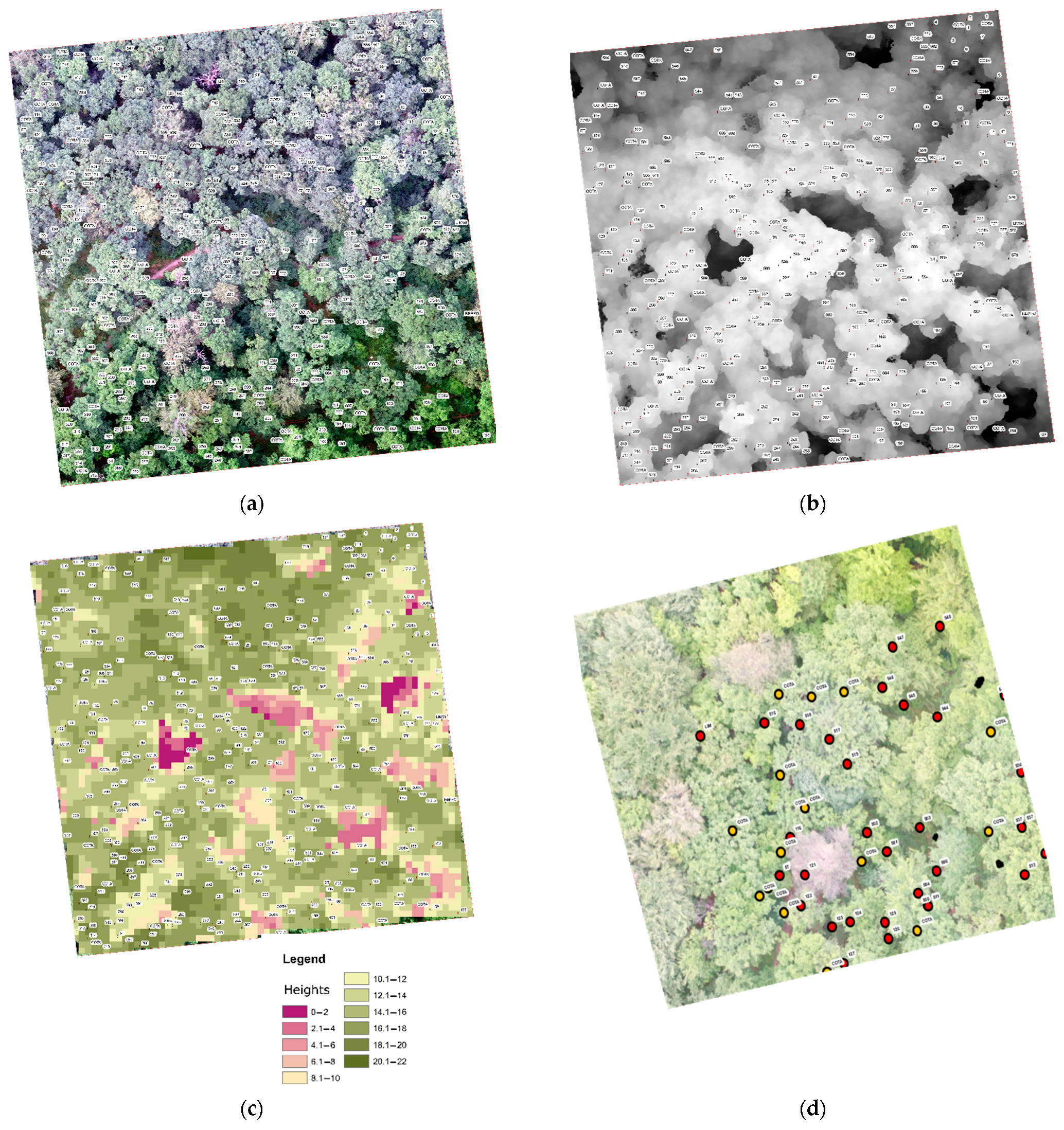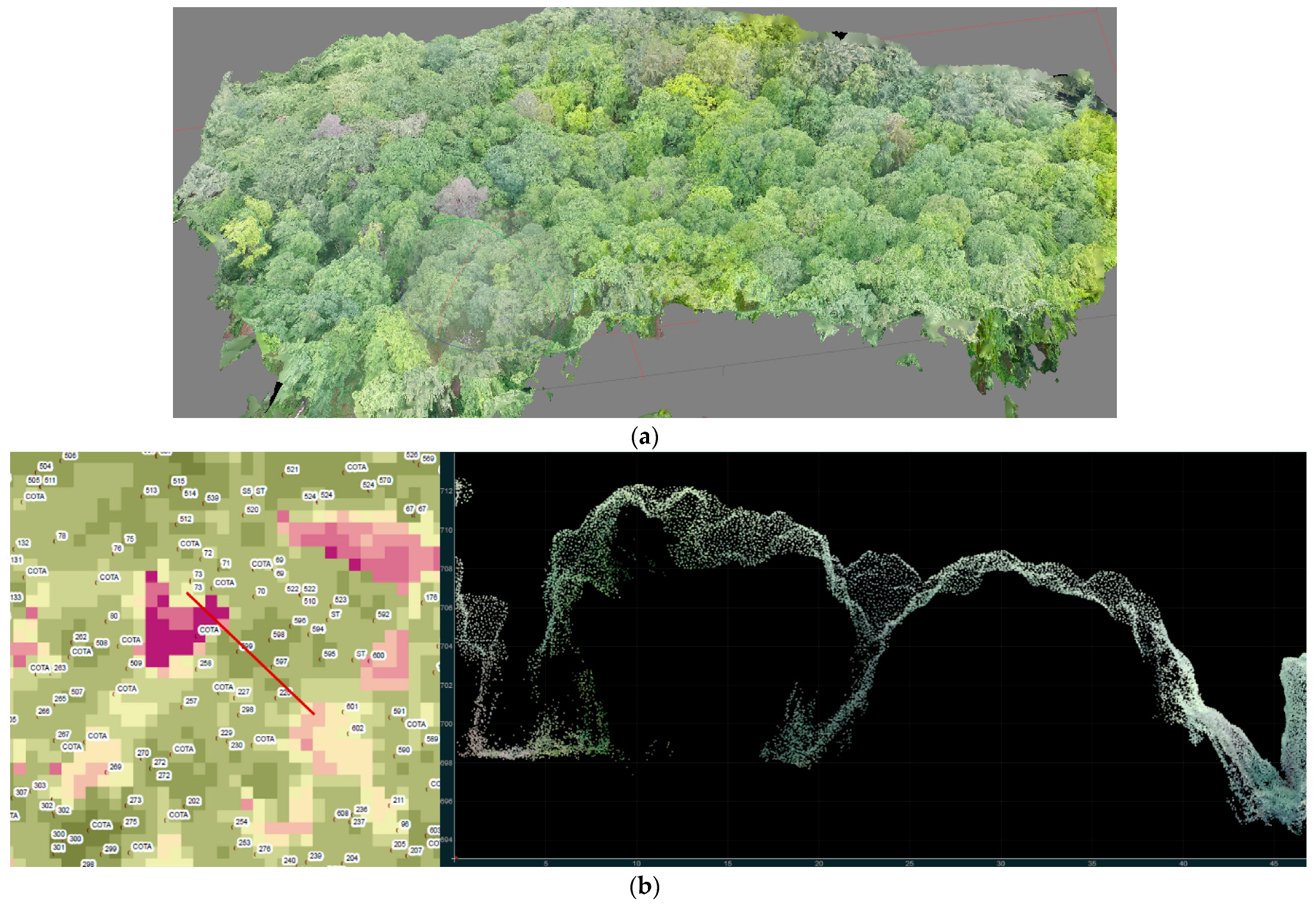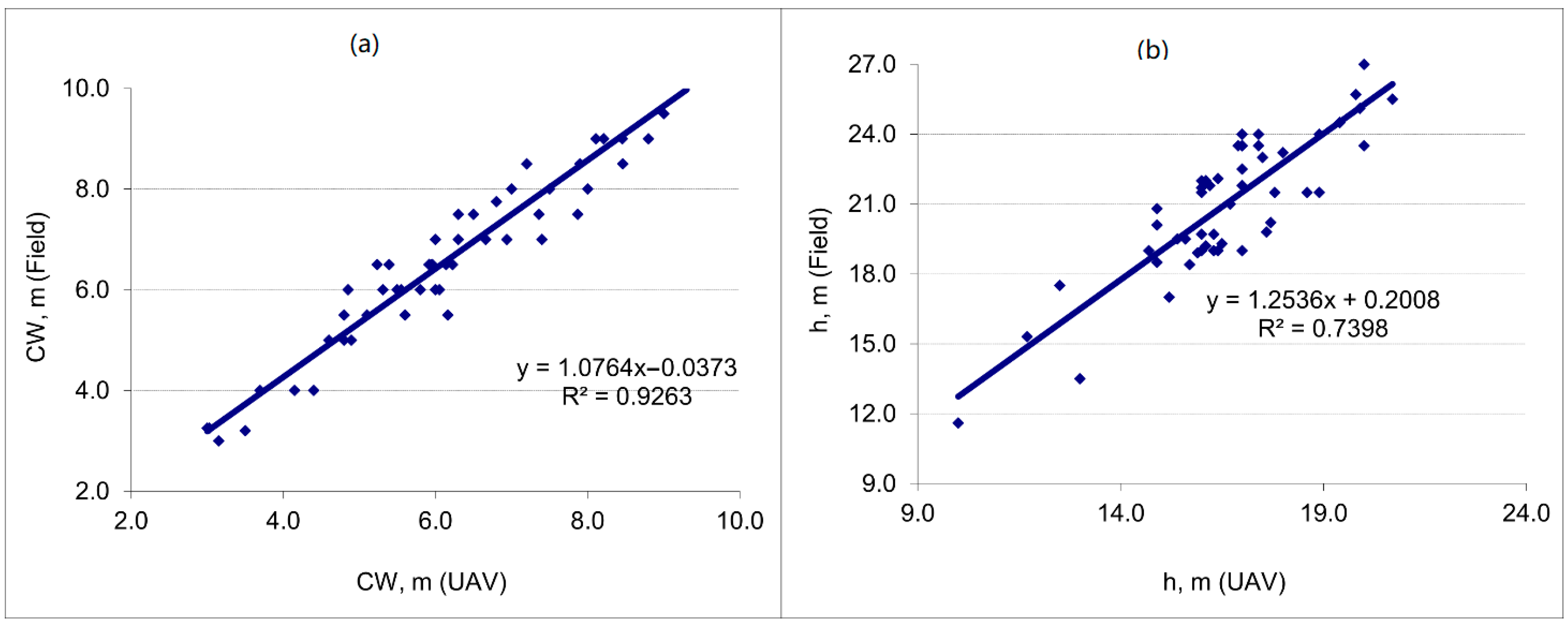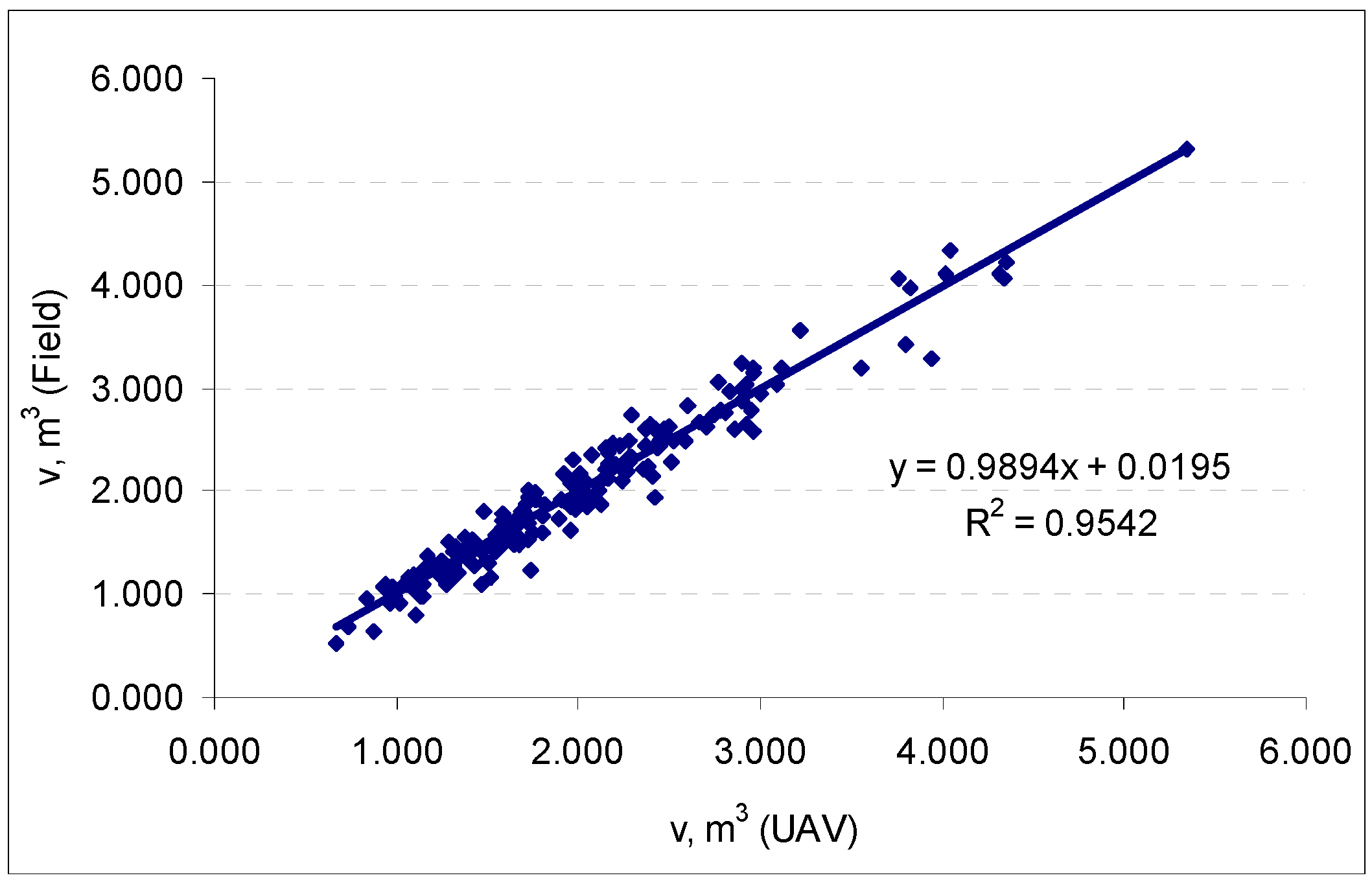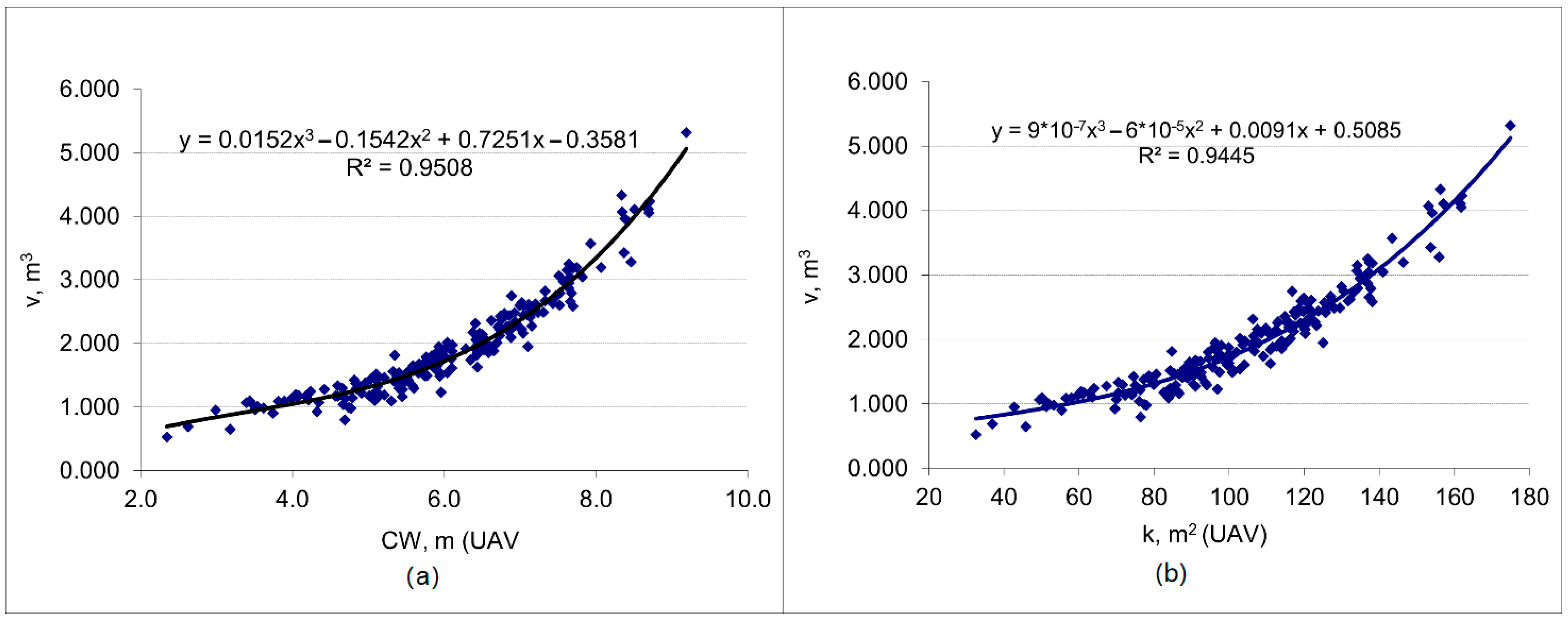1. Introduction
Field measurements are still the most accurate data source upon which forest management planning is based. The development of unmanned aerial systems (UASs) has created new opportunities in the fields of mapping and the estimation of the biophysical properties of forests. Various information related to their structure can be retrieved by means of remote-sensing techniques in a relatively short time frame, and under various conditions of accessibility [
1]. UASs, consisting of various unmanned aerial vehicles (UAVs) equipped with remote-sensing sensors (i.e., digital cameras), make it possible to obtain digital images with high spectral and spatial resolutions. Thus, by using these systems and their associated processing software, tridimensional (3D) models can be generated and used in forestry applications.
Digital images, combined with photo-interpretation techniques, allow for the evaluation of the main stand parameters [
2]. Parameter values derived from digital models and orthorectified products fall within acceptable tolerance levels (±10%) [
3] when compared to in-situ measurements. The literature has highlighted the relationship between tree diameter at breast height (DBH) and crown width (CW) as being one of the advantages of this approach. Similarly, the root mean square errors (RMSEs) for height estimates show expectedly low values [
4] (RMSE = 1.712).
Using UASs equipped with small thermal, laser, or optical sensors has emerged as a promising alternative to obtaining 3D models, and is more frequently being used in forestry applications [
5]. Data processing techniques makes it possible to use high-resolution images and 3D data in forest monitoring activities [
6,
7,
8,
9,
10,
11], as well as in taking forest inventory and remotely measuring tree variables [
1,
12,
13,
14]. Several studies have focused on estimating the biometric characteristics of either forest stands [
15] or individual trees by means of the segmentation of digital models [
11,
16]. The use of UAV laser scanning provides values for features, such as tree location and height, with accuracies comparable to those reached from ground measurements [
17,
18]. An important aspect to be considered is the fact that features such as stand volume, basal-area weighted average height (Lorey’s mean height) and average and maximum height [
15] were better estimated when the dominant-tree model was used in the calculations.
Fitting UAVs with active laser sensors (UAV-LSs) created the possibility to get 3D data with high resolution. This has been advantageous in the estimation of certain biophysical properties at the level of the individual tree, such as coordinates, height, DBH, CW, pruning height, biomass variation, and rate of pruning [
1]. Studies on tree stems and their diameters, along with other structural parameters, have been performed, including below crown level [
19,
20]. Merging terrestrial and UAV-LS data has led to an improved inventory of forest resources [
17]. The direct estimation of aboveground biomass (AGB) without using in-situ observations has been made possible through the use of individual tree approaches (single-tree AGB) by applying allometric models based on variables derived from terrestrial laser scanning (TLS) and specific predictors at the individual tree level [
21].
TLS, in addition to associated point-cloud processing techniques using automated algorithms, provides the ability to very accurately determine stand parameters. Applied in stands characterized by variations in crown size and Kraft class, the detection rate of trees can be as high as 97.4% when DBH is above 12 cm, and 84.62% when DBH is below this threshold (as is the case in natural regenerations) [
22]. However, research has also highlighted the potential limitations of using TLS, rooted in the complexity of crown structure [
23].
UAV-LS technology is one of the latest technological advances, enabling tree-height measurement with an accuracy equivalent to that of forestry applications requirements [
24]. Reduced RMSE values (8.6–12.7%) have been attained in the measurement of DBH by means of the supervised processing of TLS along with UAV-LS data, and even better results have been achieved when fully automated processing was used [
25].
UAV photogrammetry provides acceptable results for the delineation of crowns, but at a lower cost than UAV-LS [
26]. Digital-photography-based canopy height evaluation, due to its high resolution, allows for the extraction of dendrometric features at the stand scale, being more efficient, in particular, for estimating the dominant height in stands of uniform structure [
27]. The accuracy of the results is influenced by stand structure. Consequently, the processing of UAV data using structure-from-motion (UAV-SfM) techniques can deliver results similar to those obtained by airborne laser scanning when addressing the biometric characteristics of stands (i.e., dominant height, basal area, aggregation trend of DBH/quadratic mean DBH). UAV allows for the acquisition of high-resolution images at low cost. UAV-SfM data can be used in a complementary manner, rather than as an alternative, to LiDAR data [
28], while remaining a suitable tool for observing crown phenology at high temporal resolutions [
29].
Despite all the advantages of remote-sensing approaches, stand structure remains one of the main drivers influencing aspects of instrument selection or measurement accuracy. For tree-level determinations, UAV is an effective system for estimating biometric variables.
With regard to the limitations of the UAV-SfM technique, it is notable that not all trees in a stand are visible on the resulting digital surface models (DSMs), which results in the computations being applied only to higher-level trees or isolated individuals. Conducting measurements only on trees belonging to the mean-tree category, considered to be representative of all trees in a stand, greatly simplifies such computations. The number of trees addressed is determined in a probabilistic manner, in relation to the variability of their dimensions. The trees in the sample can be selected proportionally, in relation to their basal area or volume-by-diameter categories. Tree and stand volumes have been determined using models based on biometric variables measured on digital models (obtained from UAS data). Since these biometric variables include crown dimensions and tree height, they can be included in models that calculate volume. As a stand structure forms the shape and dimensions of trees, appropriate models have to be developed, based on structure type. Through this study, we aimed to develop models for the estimation of sessile oak (Quercus petraea) stand characteristics (such as DBH and volume), based on variables measured from UAS digital surface models (i.e., crown diameter and tree height). The accuracy of the determinations was analyzed with reference to values obtained through a classical inventory of the entire 170-year-old sessile oak stand.
2. Materials and Methods
Table 1 gives the acronyms for the addressed biophysical variables.
2.1. Study Area
The study was carried out in the forests near Brasov city (45°38′ N, 25°35′ E), in Romania’s central region. This region is rich in different forest ecosystems, from sessile oak stands at lower altitude to Norway spruce stands close to timber line.
For this study, stands with protective functions, situated at the upper limit of their bioregion, and comprising sessile oak as the main species and beech with hornbeam as the mixing species, were selected. The silvicultural treatments applied to these stands have a very conservative character, aimed at recreating the conditions found in naturally regenerated stands and ensuring their permanence, in order to exercise the continuity of their protective functions.
2.2. Field Measurements
Plots were placed in two sessile oak stands. Plots S1 and S2 were installed in a 170-year-old stand, each covering an area of 0.5 ha (50 m × 100 m; 45°38′ N, 25°33′ E). In both plots, the slope of the terrain was 10°. S1 was placed in a mild soil microstation on the sun-facing side of the mountain, while S2 was located in a shadowed microstation with deeper soil. Plots S3 and S4, measuring 1 ha each (100 m × 100 m), were installed in another stand, aged 110 years (45°38′ N, 25°34′ E), on a 20° slope partially facing the sun. An increased variability in the biometric variables of the trees allowed for the development of valid models only for the older stand plots. As such, the 110-year-old stand was used only for testing the generated models.
For each tree in the sampled areas, we measured DBH, height, pruning height, and crown diameter (CW). The wood quality and Kraft class were also evaluated. The stem diameter was derived from the circumference. The height and crown diameter were measured using a Vertex hypsometer and a Criterion laser. For the older stand, the (X, Y) coordinates of each tree were determined using survey engineering methods and a Leica TC 407 total station. Knowing the coordinates, the listed trees could be positioned on the cartographic support (
Figure 1a). Also, by means of the total station, the field elevations (Z) were recorded, to obtain a digital terrain model. To improve the accuracy of the determinations, four connection marks (tie points) were placed on the ground in such a manner that they could easily be identified on the digital images. Digital aerial images were acquired, using a DJI Phantom 3 Advanced UAV, from a height of 56 m, and with a 90% overlap. The automated flight of the UAV was aided by the use of Global Navigation Satellite System technology. The accuracy of the model (averaging 0.7 m XY and 1 m Z) has been improved by using four ground control points recorded through the GNSS technique. These have served as references, forming the basis for orientating the digital model. After compensation, an RMSE value of 1.03 cm was obtained on X axis and 1.40 cm on Y axis.
2.3. Measurements Made on the Digital Model
After assembling the digital images and georeferencing the point cloud, the SfM technique allowed the extraction of a DSM, as well as other models necessary for further processing (
Figure 1b,c).
The 3D point cloud (
Figure 2a) was generated using Agisoft Photoscan software. The canopy height model was generated by first normalizing the point cloud (reducing the heights to a reference plane) followed by barycentric spike free interpolation [
30] resulting in a raster with a 1 m × 1 m spatial resolution. Control cross-sections were traced on the resulting model in order to evaluate the height of the trees from the CHM.
2.4. Data Analysis
A synthesis of the field data can be found in
Table 2. In the studied stands, the sessile oak proportion ranged from 56% to 91%.
Due to the structure of the stands, not all trees could be identified on the digital model. This was because they had similar heights and, consequently, overlapping crowns. Isolated trees were visible and easily identifiable. In cases where the crowns could be individualized, the characteristics visible on the digital model (i.e., crown projection area of tree and tree height) were extracted. The number of individual trees measured on the digital model was established using a probabilistic approach [
1] based on the variability of the biometric characteristics of the trees, as described by the field measurements (
Table 3). Thus, the selected sample implies a tree volume determination error no more than 10% at a probability of 95%. On the digital model, the sample trees were identified on the plots using their field-measured coordinates. They were selected in relation to their basal area and diameter categories, determined from field measurements. Most of these sample trees were selected from median-diameter categories, and particularly in the diameter category of the mean tree, considering the basal area. Trees in this category had average crown diameters. Thus, the average diameter of the sample trees was very close to the d
g value. The CWs of the sample trees were deducted from the crown projection areas measured on the digital model. For trees that were not clearly individualized on the digital model, CW and tree height were determined based on models expressing the DBH-CW and DBH-tree height relationships. These models were designed based on characteristics measured at the individual tree level.
Lastly, based on the digital model, the crowns of all the trees were vectorized. The crowns of grouped trees that could not be precisely individualized on the digital model were treated as a unique value, and vectorized as such. The canopy projection area of the trees was used in a simplified volume determination process (i.e., processing of the mean tree, considering the volume).
The volume of each tree was computed as a function of DBH and tree height, following the regression equation developed for Romanian forest species [
31,
32]:
In Equation (1), for sessile oak, the coefficients take the following values: a0 = −4.17315, a1 = 2.27662, a2 = −0.09084, a3 = 0.57596 and a4 = 0.093429.
In order to determine the biometric variables of the ideal trees that were included in the models, correlations to the characteristics of the trees inventoried in the field (
Table 4) were considered.
The main variable for accurately estimating tree volume is DBH. The influence of structural and site conditions on the size of trees leads to models that express the relationship between the biometric characteristics of the trees that need to be developed separately for each structure type.
Models established at both the individual tree and stand level were based on relationships between the tree characteristics (i.e., crown projection area, crown diameter, and tree height), determined from the digital model and those determined through field measurements (tree DBH, height, and volume).
4. Discussion
Focused around developing mathematical models based on trees variables measured on DSM, this paper analyzes the possibility of extending them towards stands of different structural conditions. Considering this, we resorted to a methodological approach, showcasing the holistic use of UAV technology and dendrometrics, rather than further developing previous research.
4.1. Accuracy of Evaluated Biometric Variables
Several models for estimating the biometric variables of trees measured from digital models obtained by means of UAV technology were tested. Tree crown was found to be a reliable source of information regarding tree DBH in the case of stands with even age structures, uniform densities and a low height coefficient of variation. For the tree crowns, the RMSE values ranged from 15.33 to 20.21% (
Table 9). These values are consistent with results from previous studies ([
13]: RMSE = 14.29–18.56%). These results are specific to the particular stand structure of the studied plots, as this shapes the size and geometry of the trees. Variable density in the stand influences the d-CW relationship. An analysis of the ratio between the two computed characteristics (CW and d) from field data gave
R2 values of around 0.70, while similar research [
4] has shown that the relationship is stronger if crown diameter is used. Using the generated models (Equations (2) and (3)), the DBH values were estimated as being close to those measured in the field, with low RMSE values (0.32–0.89%). Since using the digital model to measure trees favors individuals from the upper levels of the canopy [
33], for stands with grouped crowns, the canopy should be vectorized as a whole. The mean tree of the stand can be used to simplify the calculation of the stand volume (i.e., the mean tree when considering the basal area or volume) for such cases. The crown diameter of the mean tree in the stand can be estimated based on the diameter of the upper-level trees, which is more easily visible on a digital model. Applying Equations (11) and (12), based on the use of mean-tree variables, led to 1.1–1.8% smaller values relative to the volume determined from field measurements.
DBH is a variable that allows the easy estimation of tree volume. Equations (7) and (8) indicate that around 95% of the variation in tree volume can be explained by variation in the crown diameter, determined by measurements from the digital model. When implementing Equations (7) and (8), the results showed little difference to those from field measurements, with the RMSE reaching values of between 8.82 and 9.60%.
In general, the values obtained from measurements from the digital model are close to those determined from field measurements. However, determinations using the digital model showed problems in capturing the heights of all the trees. The errors in determining tree height increase with an increase in tree height, under conditions of an intimate mixture of trees with different heights and closer to each other (i.e., increase of stand density). The differences between the estimated and field-measured height values are highlighted by RMSE values between 10.40 and 11.70%, which support the findings of previous studies ([
1,
13,
15]: RMSE = 11.42–12.62%). For the mean tree of the stand, considering the basal area approach, for plots S1 and S2, respectively, characterized by heights between 19.6 and 23.3 m, only 17 and 25% of the real heights were estimated. For the mean tree, when considering the basal area, the sub evaluated height values measured from the digital model gave a lower volume than the reference by 14.3 (for S1) and 21.2% (for S2), respectively. As a consequence, it was necessary to calibrate the heights measured from the digital model by linear models, as expressed by Equations (5) and (6). Following calibration, the resulting volumes were identical to the reference volumes (with the exception of S2, with a 0.02% smaller volume).
Research carried out under different flight conditions (altitude 60 to 140 m, overlap between 80 and 95%) using the same UAV [
34] showed that these conditions have a negligible effect on errors when measuring height. For tree heights up to 26 m, errors often reach 4 m, and tend to increase as the height of the trees increases.
The models generated in this study, based on digital model measurements, led to RMSE values of around 9% (
Table 9), close to those achieved in other studies [
1,
15]. At the stand level, by applying Equation (10), the RMSE was 11.12% (
Table 4). This can be explained by a much greater increase in DBH in comparison to heights from the old stands, with aspect also highlighted by the slenderness index values (
Table 2). The increased percentages (over 80%) for DBH, in terms of volume growth, produced an increase in k in Equation (10).
Using mean-tree variables considering the basal area to determine the volume of a stand using Equation (11) rather than mean tree considering the volume led to negligible volume differences (0.52% lower than the reference volume in plot S1, 0.65% in S2,
Table 9). This suggests that either of these two approaches can be used for determining the volume of uniform-structured stands.
4.2. Limits of the Established Equations
The models generated in this study may be used for sessile oak stands of similar structure (where the slenderness index has values close to those shown in
Table 2) that also experience similar environmental conditions. Our study shows that, for similar crown diameters, trees from different production sites may have different DBHs (
Figure 7a). Similar influences are also exerted on tree height. At the same DBH, with the same crown diameter, tree height varies widely under the same situational and structural conditions (
Figure 7b).
Crown diameter is a good indicator of DBH, but the strength of their relationship is specific to each structure. At the species level, models based on this relationship must be differentiated according to the age of the stand, their density and the productivity category. In medium- and superior-productivity sites, the correlation between crown diameter and tree height decreases with an increase in stand density. Therefore, the relationships between crown diameter and other variables are more stable where trees are systematically treated to avoid large variations in density from time to time in a stands’ development.
This highlights the fact that relationships addressing tree volume based on single traits cannot be generalized. In the calculation of tree volume, in addition to DBH and crown diameter, tree height should also be included. From the structural analysis of the studied stands, no strong correlation between tree volume and crown length could be extracted. Also, this correlation is reduced if pruning height is taken into account.
The accuracy in determining the main tree and stand biometrics depends on the quality of the digital surface model. Environmental factors, such as wind speed, solar position relative to the UAV, and temperature variations can influence the quality of the recorded information. In addition, it should be noted that reflected light from the canopy, the stand composition and its vertical structure [
11] are factors that can influence the quality of the digital imagery. Field conditions must also be considered. Sometimes, with hard-to-reach plots, the cost of the associated activities and the conditions for processing the recorded data can increase. Despite these drawbacks, UAV technology is an effective tool that can be used in forest management planning and inventory practices. Crown diameter and tree height are variables that can be easily computed by processing digital images acquired using UAVs. However, the use of other techniques should not be excluded. The structural complexity of a stand can determine the most appropriate technology, or combination thereof, to be used.
5. Conclusions
This study highlighted the possibility of estimating the main tree and stand biometric variables using information provided by UAV image processing. While digital models are crucial in delivering the most accurate results, understanding their limits allows mathematical models to be generated that can further improve the accuracy of the determinations. However, these models can only be replicated by using the same technologies and techniques, and only for similar trees and stand structures. The determination of mathematical models involves taking into consideration in the equations several variables that relate to a stand’s structural features. The two variables that can most easily be measured from the digital model are crown diameter and tree height. Used together, these increase the accuracy of the results.
Simplified procedures, based on the relationships between the biometric characteristics of trees that can be measured from digital models, can also be applied to the determination of stand volumes. Thus, such procedures may be applied for the rapid determination of volumes under conditions where precision is not required.
Tree features, such as DBH, height, and crown dimensions, vary in relation to stand structure. Therefore, when developing models based on these variables, stand structure, species composition, and age class should be taken into consideration.
